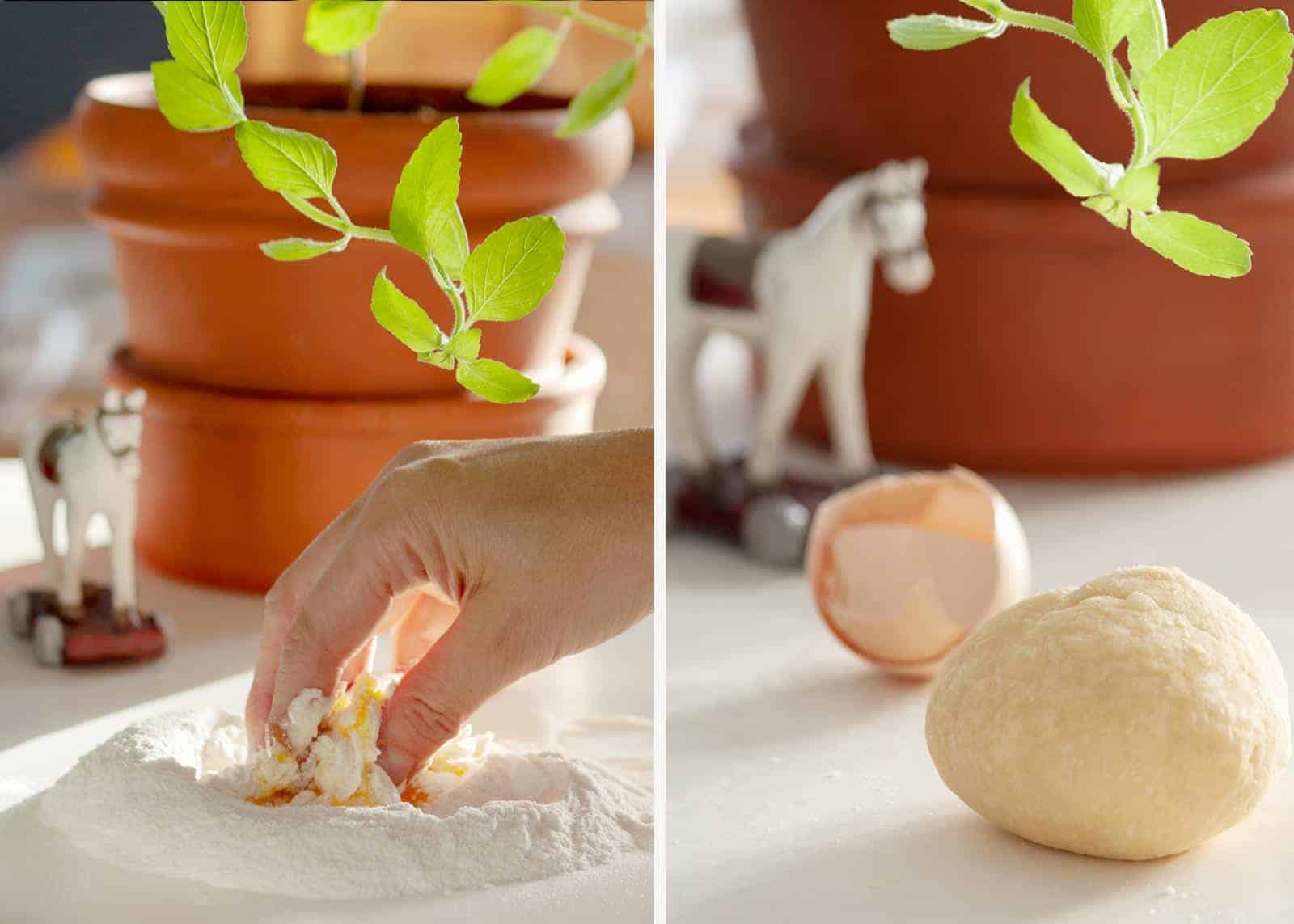
If you love Italian cuisine, you simply have to try pasta fresca. Making your own pasta is really not rocket science. And if you follow the tricks that I learned from my grandmother, Nina, you will definitely become a master at making fettuccine all’uovo.
Jump to RecipeRibbons of pasta
Lasagna, fettuccine, pappardelle and tagliatelle were the first types of pasta that my Nonna Nina taught me about. Some of these „ribbon noodles“ are made with egg in northern Italy, which is where I come from. The flour is a farina doppio zero (comparable with type 480 in Austria, and type 405 in Germany), a white flour with less gluten than other wheat flours. Commercially available ready-made pasta is made with semola di grano duro (durum wheat flour), but at home we only use this for pasta without eggs.

Handmade or with a little help
The easiest way to knead the egg dough is to use the balls of your hands: push it away with some force, fold it over, and push away again. My Nonna swore that the secret is to always turn the dough in the same direction, and to knead it for at least 10 minutes. Nonna Nina also relied on the power of her hands for the next step: the dough was pulled apart, then rolled thinly with a rolling pin and cut with a knife. It is, of course, easier to use a pasta machine for this, but only handmade fettucine have a rough surface from the wood, and because of this, they absorb the sauce better
How to cook and enjoy pasta fresca
As is the case with ready-made pasta, freshly prepared pasta is also cooked in salted water (10g of salt and 1l of water per 100g of pasta). To put the pasta into the pot all at once, my Nonna had a little trick that I’m going to share with you: she wrapped the pasta into a tea towel which she then held together at both ends. She held this above the pot and then let go of one end of the towel and the pasta would just glide into the bubbling water. Pasta fresca only takes a couple of minutes to cook. Stir with a wooden spoon from time to time so that the fettuccine do not stick together. And very important: freshly prepared pasta does not like to wait! Family and guests should already be waiting at the table, otherwise the fettuccine could stick together .
📖 Recipe

Fresh fettuccine
Ingredients
- 400 g flour 00, type 480 Austria, 405 (Germany), 400 (Switzerland)
- 4 eggs
Instructions
- Place the flour onto a clean pasta board and form a hollow in the middle. Crack the eggs into the hollow. With your fingertips, mix together the eggs with the flour from the inside out. Knead the dough with the balls of your hands and with the force of your whole body, until all of the ingredients are properly mixed together (this takes approx 10 minutes). Wrap the dough in plastic foil and let it rest in a cool spot for 15 minutes (not in a refrigerator).
Hand rolled and hand cut:
- Sprinkle the pasta board with flour. Pull the dough apart a little, then roll it out quickly with the rolling pin until it is about 1mm thin. Fold the rolled out pasta dough loosely on top of each other several times from the thinner side: when you are finished, it should be about 8cm wide. Now cut the folded pasta dough with a sharp knife lengthwise into approximately 5-6mm wide strips. If the fettuccine is too long, cut it again. Fatto! You did it!
With a pasta machine:
- Cut the dough into pieces. It is said that you should have three times as many pieces of dough as there are eggs in it. In our case, that would mean 12 pieces. This means that each portion of the dough has just the right size for the pasta machine. Now pull the dough through the machine one by one until it is 1mm thin. Place the finished dough sheets next to each other on a cloth. Then, select the wide cutting setting (for fettuccine) on your machine and pull each dough sheet through.
- Cook the fettuccine in plenty of salted water as described above. Add the sauce to the strained pasta immediately and mix together with a fork and spoon until the sauce covers the fettuccine. Serve the fettuccine hot.
Nutrition
A spoonful of knowledge:
Fresh pasta is more absorbent than its industrial counterpart, so you need a little more sauce than for ready-made pasta. Egg pasta is perfect with strong sauces with vegetables, cheese or bacon. My Nonna liked to add a few drops of olive oil and a small chunk of fresh butter into the pasta. A little grated Pecorino on top and one of my favourite dishes was ready to be enjoyed
Buon appetito!






Leave a Reply